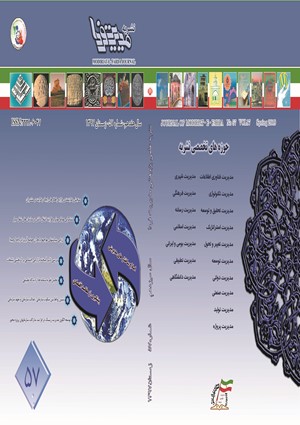مدل ارتباطی موثر بر اثربخشی آموزش ضمن خدمت سازمان ها
محورهای موضوعی : مدیریت دانشبهروز کاوه یی 1 , افسانه مظفری 2 , معصومه کبریایی 3
1 - سازمان سنجش اموزش کشور
2 - دانشگاه ازاد اسلامی واحد علوم و تحقیقات
3 - دانشگاه ازاد اسلامی واحد علوم و تحقیقات
کلید واژه: مدل ارتباطی اثربخشی آموزش سازمانی یادگیری,
چکیده مقاله :
در سال های اخیر و همگام با پیشرفت های صورت گرفته در حوزه ارتباطات، عرضه خدمات آموزشی در ابعاد و اشکال مختلف در سطح جهان بیش از پیش مشهود است لیکن آنچه اهمیت آن را برای سازمان ها دو چندان می کند، وجود مدل بهینه ارتباطی است تا بتواند اثرگذاری آموزش سازمانی را ملموس تر نموده و سازمان ها را در پیشبرد اهداف شان یاری نماید. این پژوهش به دنبال طراحی مدل ارتباطی موثر بر یادگیری در آموزش سازمانهاست که با استفاده از روشهای کیفی و رویکرد مبتنی بر نظریه داده بنیاد انجام شده است. ابزار جمع آوری داده ها، مصاحبه های نیمه ساختار یافته بوده و بمنظور گردآوری اطلاعات، با بکارگیری روش نمونه گیری هدفمند با 15 نفر از مدیران، مدرسان و پرسنل بانک ملت مصاحبه انجام شد. تجزیه و تحلیل داده ها در سه مرحله کدگذاری باز، کدگذاری محوری و کدگذاری انتخابی انجام گرفته و بر اساس آن، مدل کیفی پژوهش طراحی شده است. نتایج پژوهش حاضر، نشان دهنده استخراج بالغ بر 678 کد از مصاحبه ها 197 مفهوم و 27 مقوله است که در قالب مدل پارادایمی شامل اثربخشی آموزش سازمانی به عنوان پدیده محوری و شرایط علی، شرایط مداخله گر، راهبردها و عوامل پیامدی قرار گرفت.
In recent years, with the advances made in the field of communication, the provision of educational services in various dimensions worldwide has become more evident but what makes it more important for organizations is the existence of an optimal communication model to make it more tangible for organizational learning and helps organizations advance their goals. This research is aimed at designing an effective communication model for learning in organizations' education, which has been done using qualitative methods and approach based on the grounded theory. Data collection tools were semi-structured interviews and interviews were conducted with 15 managers, teachers and staff members of Mellat Bank to collect information using a targeted sampling method.Data analysis was conducted in three stages: open coding, axial coding and selective coding, and based on this, a qualitative research model was designed. The results of this study indicate that the extraction of over 678 codes from interviews has 197 concepts and 27 categories that have been considered as a paradigmatic model including the effectiveness of organizational education as a pivotal phenomenon and causative conditions, interventional conditions, strategies and consequential factors.
امین الرعایا، سعیده و احمدی ، غلامرضا و نادی ، محمدعلی ، (1388). بررسی مولفه های سازمان یادگیرنده با یادگیری سازمانی در دبیرستان های دخترانه شهر اصفهان. فصلنامه رهبری و مدیریت آموزشی. سال سوم، شماره4 ، زمستان1388، ص 73-91.#
ساعتچی ، محمود.(1382). روانشناسی بهره وری. تهران: موسسه نشر ویرایش ارسباران.#
Abbot,J.Learning make sense :re-creation education for a changing future.Letchworth :Education.1994.#
Bonwell,Charles; Eison,James. Active learning:Creation excitement in the classroom. ASHE-ERIC Higher Education Report1.Washington,D.C:George Washington University,1991.#
Chirp, S. 2001. "E-learning"; Available at: www.the journal.com/ magazine/ vault/article print
version.Cfm? Aid=3397.#
Creswell,J.W. (2005), Educational research : Planning,Conducting, and Evaluating Quantitative and Qualitative Research (2nd edition).#
Demirel, M. , Lifelong Learning and Schools in the Twenty-first Century, Procedia Social and Behavioral#
Gunn,Holly.Virtual Libraries, supporting student learning.(2002).available: http: www.accessware.ca/hgunn/special/pappers/virlib#
Hilgard, E. R. ; Bower, G. H. ; (1975),“Theories of Learning”, (4th ed), Englewood Cliffs, N.J:Prentice- Hall#
Hsieh, Hsiu-Fang, & Shannon, Sarah E. (8001). Three approaches to qualitative content analysis. Qualitative health research, 11(9), .1822-1811#
Lohman, M.C. (2005). A survey of factors influencing teachers engagement in informal learning groups in informal workplace learning avtivities.HUMMAN RESOURCE DEVELOPMENT QUARTERLY 16(4), 501-527.#
Neuman,D,"Learning and digital library".Library trands, Vol.45,No.4(1997):687-708#
Parker,Ch.D.2004.A descriptive study to identify deterrents to participation in employer-provided e-learning. Unpublished doctoral dissertation. CAPELLA UNIVERSITY. Degree PhD.#
Starr, S. (2003), Application of Mobile Technology in Learning & Teaching:M-learning, Learning & Teaching Enhancement Unit (LTEU), Briefing Paper.#
Talja, Sanna. (2007). The role of formal and informal learning . Journal of workplacelearning . Vol.19. pp. 469-481.#


